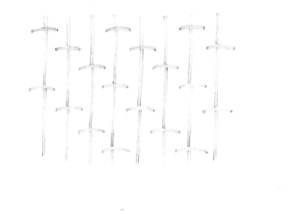One of the three basic weaves, the others being plain ( tabby) and satin, that between them create every woven pattern that is.
The twill weave is the one that creates a characteristic surface pattern of usually 45º diagonal lines or ribs across the cloth. This is achieved by floating, or passing weft yarns over one or more warps and then under one or more; this sequence is repeated at every row, each time progressing by one warp, which moves the pattern along–the twill weave dips of 45° from left to right or right to left.
* Twill can be warp faced or weft faced, depending on which side shows the most distinct pattern, as opposed to cross weave fabrics which have identical sides.
* At first look, a twill may look similar to a satin weave, so check the back–a satin fabric will have a plain back. twill weaves are hard wearing and durable, and can be found in every yarn and fabric from work clothes (dungarees) to uniforms (cavalry twill) to jackets and coats, and upholstery. Warp and wefts in two toning or complementary yarn colours create interesting effects.
* Examples of cotton twill weave fabrics: denim, flannelette, gabardine, wool, baize, tricotine, surah, herringbone.

